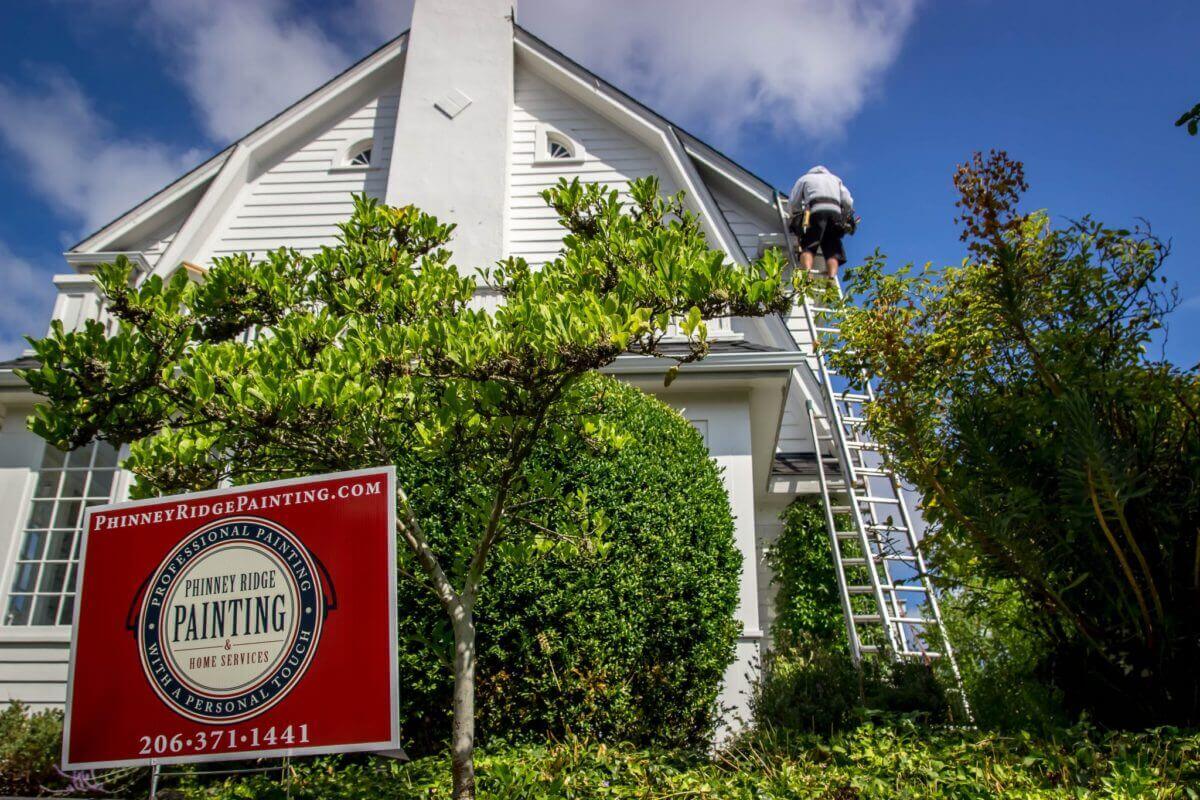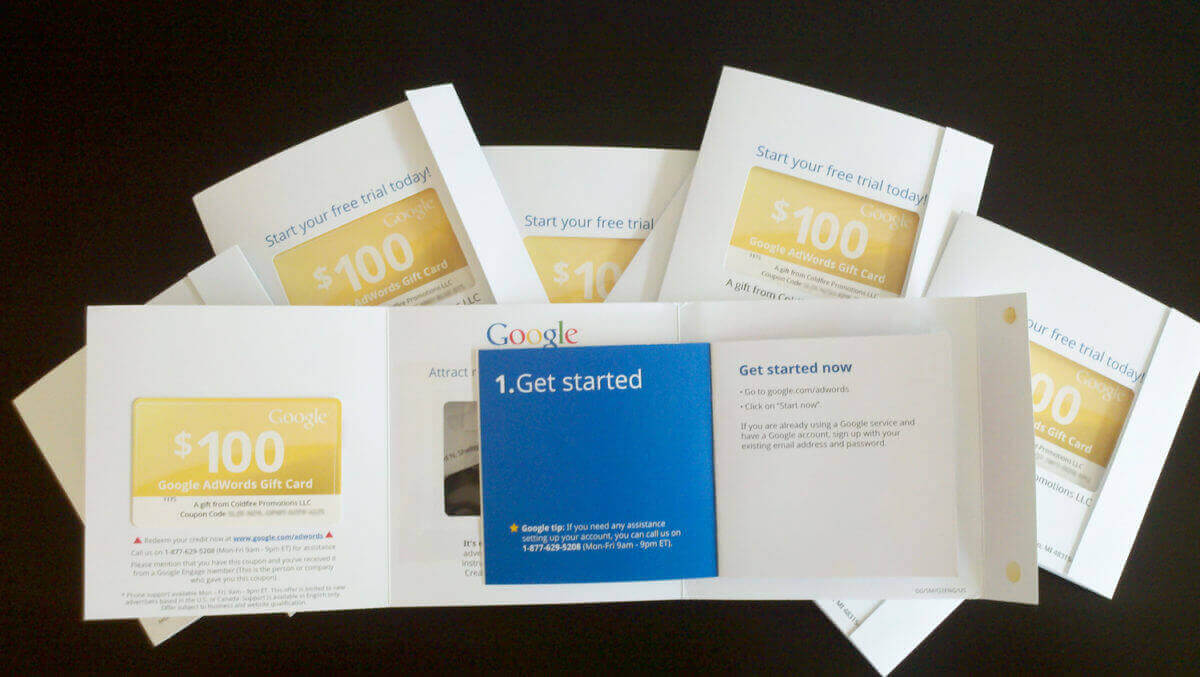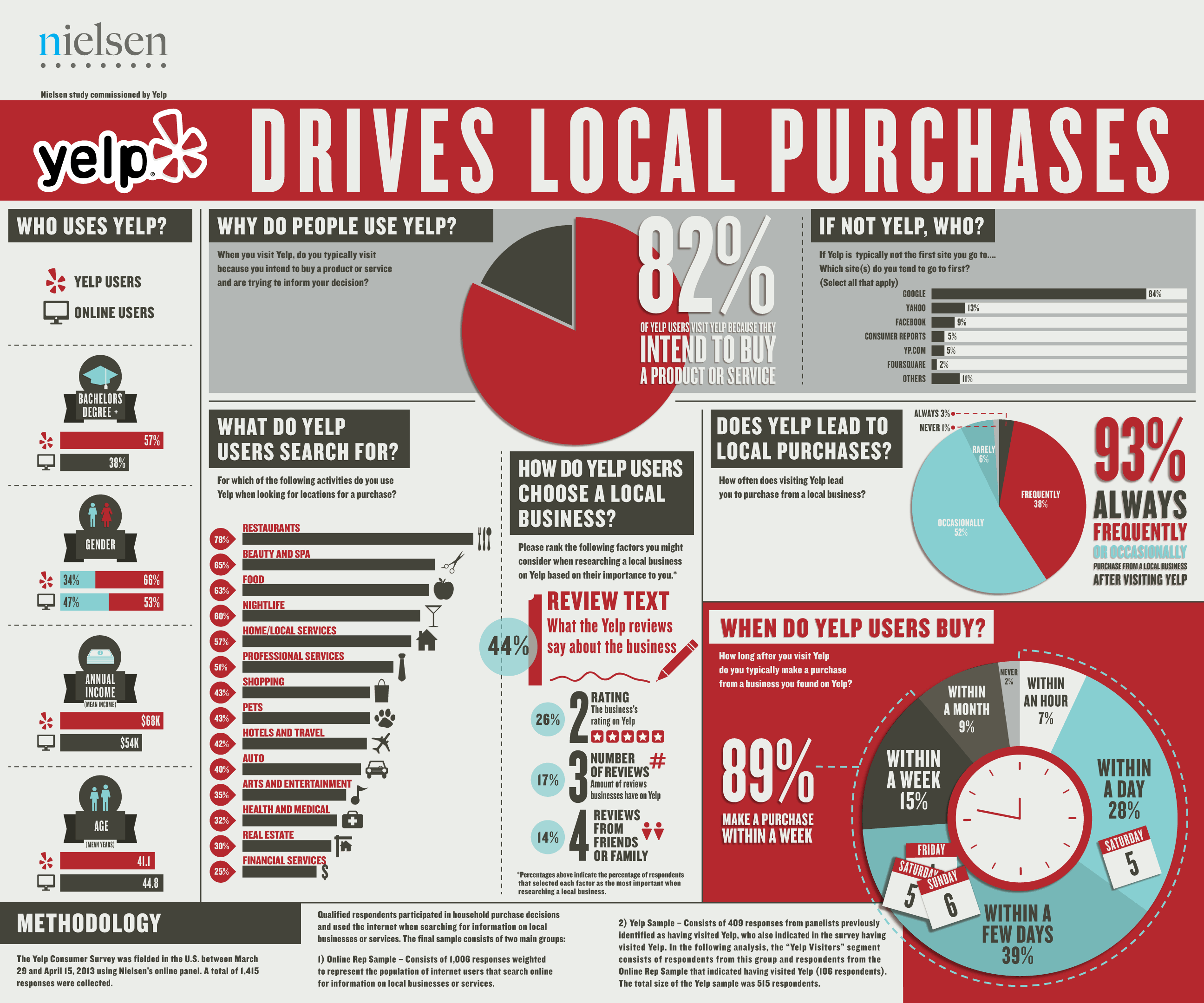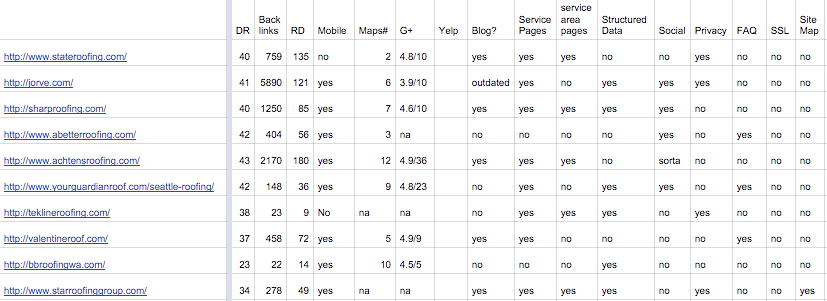
Understanding Home Service Google Results
21 min readNot only is getting your home service business “ranked no. 1 on Google” easier said than done, it really doesn’t mean anything at all. Rather everyone should take a step back and look at actual search engine results and understand each element, how it is generated, and develop a holistic strategy to increase general visibility across all platforms rather than being stuck in an unrealistically narrow objective.
To illustrate this, we decided to break down the actual search engine results and explain what the different elements are, how they get there, and how you can use those elements for your advantage.
We began by as simple search for “Seattle Roofers.” We’ve broken each part of results down to major elements that we will explain below:
1. Adwords:
The primary money maker for Google is the ad section that appears on the top and right hand side of search results. Most small businesses receive solicitations that include a gift certificate for a few hundred dollars of free advertising in this section just to get their feet wet.

These ads are all bid on with automated tools, with max budget, cost per click, all being controlled by you the client. But managing and optimizing your Adwords account is a little more complex than it may seem at the surface. The following are the best ways to optimize your Adwords campaign in order to receive the highest ranking in this section, lowest cost per click, and highest conversion rate:
- Understand your ideal cost per acquisition. There is quite a bit of math involved in ensuring that you’re getting the most out of your Adwords campaign, but every equation needs a starting point. In the case of Adwords, a business owner needs to look at their margins on a service and calculate how much they are willing to spend to get a gig. Normally this is around 6% of the value of the project, but it does vary depending on the kind of service and size of the project. Once your ideal cost per acquisition is established, you can divide that by your conversion rate, which is the number of people who visit your page vs. actually turn into a client, that then needs to be divided. We understand this is a little ambitious, so we made a little work sheet to help calculate backward to find the maximum you should be spending on your display ads. You can download that here.
- Narrow your target keywords based on value, and need. Ideally identify the top 20 keywords, that have a cost per click within your budget. The top keywords will be calculated by volume of monthly searches as identified by the keyword planner.
- Build your text ad around the keywords you have selected, by either answering the question being asked, or directly including the most common words in the they keyword phrase into the headline of the ad itself.
- Make sure you have a good call to action in the secondary lines of the the ad
- Include localization, and if possible review and phone extensions on the ad itself.
- Create a unique landing page specifically for your ad group, that matches the copy of the ad, and has a clear and concise call to action. This will directly impact a ranking factor called relevancy score, and if done right will reduce the price of your clicks. This is because Google wants to provide the most valuable ad to it’s clients, the searchers.
- It’s ideal to use a heatmap and analytics to track the conversion rate of the page. An ideal conversion rate is about 3% of the visitors, so keep an eye on the results from the page. If the conversions are not ideal, use the heatmap to understand what people are actually doing on the landing page and make changes where the evidence indicates there may be a problem with user experience.
- If possible use a landing page tool that allows you to split test landing pages with alternative ad copy, images and placement of calls to action.
- It’s ideal to use a heatmap and analytics to track the conversion rate of the page. An ideal conversion rate is about 3% of the visitors, so keep an eye on the results from the page. If the conversions are not ideal, use the heatmap to understand what people are actually doing on the landing page and make changes where the evidence indicates there may be a problem with user experience.
A note to keep in mind is that an Adwords budget should allow for at least 100 clicks per campaign. If your the average cost per click of a keyword is hypothetically $5, then your budget should be at least $500/month. A budget smaller than that will result in nearly unmeasurable results, rendering your adwords campaign little more than a waste of money, that could have been better spent in other places.
2. Local Results:

For local services such as roofers, Google assumes that you will want to work with a reputable service provider that is in your neighborhood. Because of this they include a section at the top that pulls from Google Maps, which is fed from information provide through Google+ and google.com/business. Rankings in this section have their own algorithm that is entirely separate from the organic results in of website rankings. It’s important to understand that the local results section is one of the most subjective parts of the search engine results because they are customized based on your search history, as well as the ip address from which you are searching from. This is one of the reasons why in the example used, Paramount Roofing is showing at the top, because their business address is closest to our office at Marketeering Group, where this search query was initiated from. The simplest ways to optimize your local results are as follows:
- Claim your Google Business listing. This can be done by going to Google Maps and selecting the option to claim your business. The verification for which will be done either via a post card sent to your physical address with a PIN number to be entered in, or by the phone to the number that Google believes is the confirmed business number for your company.
- Make sure that all of your directory listings that contain your address and phone number are consistent. Google trusts local businesses that have very clearly defined physical locations and phone numbers. It is using other sources like Yelp, BBB, Angie’s List and all other directories that list your address in order to create a framework of assumption of trust that the information they have is accurate. Use a tool like Yext, Moz Local, or Whitespark to scan the internet for your brand and identify any discrepancies. These discrepancies can be caused by incomplete listings, business filings that list an owners home address or cell phone, or they may be left over from pervious locations and outdated information. If this is the case it will become important to manually correct the information that is contradictory, in order for local rankings to serve you best.
- Make sure your profile is fully filled out with descriptions, videos, and proper categorization of your services.
- Request reviews from you clients. Your star rating will not show up along side of your ranking until you cross the threshold of at least five reviews. While the average ranking of your business is important, the copy of the reviews themselves are also being taken into account, especially in long tail keywords searches such as “Seattle Roofers who specialize in tile leaks.” If your client happens to mention the service that was performed that is similar to the request, this will have an impact on the rankings as well.
- Make sure that your website and social profiles all contain your full address and phone number as well. A certain markup code call schema, which is ideally placed in the header of your site, are an excellent way of providing even more trust that your listing is accurate, and correctly verified.
The localization section of Google results is one of the most inconsistent over the past few years, this is due to Google testing new ways of displaying the results including their testing with the carousal, as well as the fact that they have changed the number of listings that display in this section of the organic results.
3. Yelp and their most trusted directory of the search:

Google knows that they are not the end-all-be-all resource consumers are looking for. They understand that often times people want to first comparison shop. Because of this directories and other networks will continue to dominate the top of search engine results because it wants to best serve it’s customers. Because of this “ranking no. 1” for a given search will often be absolutely impossible for a small business, because Google has absolutely no intention of providing just one referral as “the top dog.” Instead it will refer you over to the best 3rd party resource that has proven to be useful to other people searching for the same thing.
While we can never collect enough data from every single website to have a solid understanding of what resources people are using to find their services, because of corporate data security and internet privacy regulations, we can get a great idea for people’s behavior by what Google tends to rank for resources. Clearly this search indicates that Google knows that most people who search for roofers in Seattle, primarily use Yelp as a way to explore many businesses side by side. Naturally, yelp is listed below their own localized business directory, but is is clear that they know Yelp is the second best resource.
Because of this inference that Yelp is the next best choice to refer a searcher to after their own localized results, it becomes very important to study Yelps algorithm in addition to Googles. This means that no SEO campaign should neglect Yelp optimization when competing for visibility for these services. Use the following tips for better Yelp rankings to ensure that those people who do click the first result, which in this case IS yelp, have a greater chance finding you. This also naturally helps those users who begin their search for a roofer at Yelp rather than Google, be found as well.
- Claim your yelp profile. Just like Google, unverified listings are considered less reputable than those who have claimed their profiles and built it out with more information.
- Game Yelps rankings in your own way by understanding what their ranking factors actually are.
- Like Google, Yelp has certain algorithms that dictate the way that it sorts quarries within it’s system. These is based on several factors that brake down to yelper profile strength and quality of the review:
- Yelper profile strength is determined by a combination of the Yelpers network including their friends, interactions with reviews, events attended, and who they follow, and their past activity including reviews, tips, photos posted, and the general usefulness of their reviews as determined by people’s feedback.
- The quality of the review is a combination of artificially intelligent computer reading of the review. They are looking for detail as well as people’s interaction with the review including the number of times it was read as well as the voluntary feedback people give to the review, which are the “Useful,” “Funny,” and “cool” buttons you see at the bottom, as well as the “Compliment” field.
- Like Google, Yelp has certain algorithms that dictate the way that it sorts quarries within it’s system. These is based on several factors that brake down to yelper profile strength and quality of the review:
It’s important to note that in this search result there are in fact two yelp listings. The first is the general Yelp category, because Google believes that it is the most useful third party page for it’s searchers. The second is actually the Yelp profile of the company that Google perceives to be the best result. There are two major things to note about the placement of this result:
1. Google did not select the profile of the contractor that Yelp listed at the top of it’s internal search. Rather they listed the profile that best fit Google’s search algorithm independently of Yelps suggestion. This is a reminder that you should be optimizing your Yelp page just as much as the individual pages on your website. From a value stand point it is often just as valuable for a potential client to see your yelp page as your website. To optimize both is not competing with yourself, but actually a well balance strategy.
2. Results that include directory profiles such as these are the most unpredictable component of Search Results. The first search screen shot was taken on Thursday, January 14. However, when performing a search a few days later on Monday the 18th (Martin Luther King Junior Day) we see the following:
It is perfectly understandable that the Adwords section of the page would change because everyone is bidding on different keywords, and has different settings with their ads. Also, the disclaimer about possible differences in hours posted vs. reality on a holiday are minor variations that are expected. However, the first major change that is obvious is the omission of the suggested Yelp company profile.
The reason for the omission is has nothing to do with an algorithm change, or changes in links, or content. Rather they have to do with my behavior the last time I made this search, and which pages I clicked on. Google most likely noticed that I spent more time looking at the lists of businesses rather than the company websites or profiles that it displayed the last time. This is an example of the artificial intelligence built in to Google, that is learning the kinds of content that I prefer.
4. Porch: The leading industry specific directory.

When it comes to industry specific directories, many people would think first of Angie’s List, and with good reasons. Using a traditional understanding of domain authority, Angie’s List would seem to be the better result in this instance. Angie’s List after all has a better domain rating (77) than Porch(65), and nearly 9 times as many referring domains. Even when comparing the pages, the URL rating of the Porch page that is displaying is 17… Angie’s list’s roofers page didn’t even show up on Thursday’s Search. When Angie’s List did show up on Monday’s search it was still below Porch, despite the fact that the URL rating was 19.
The reason for Porch’s strength in this search is likely to do with the rating. Porch is very smart in their hires, and we suspect that this markup is the genius work of Joanna Lord, who used to work at Moz.com. By using a star based system that is easily read and understood by Google, their rating system has been picked up and even included in Google Search. This is the section of the search results that says “Rating: 5 – Review by Porch community.”
What we’re seeing is what is called structured data markup, and is one of many schema codes that are designed to assist search engines in their indexing. Porch’s review system is fundamentally designed to provide this information to Google, which is a very intelligent way to receive special treatment. Angie’s list, however rates their providers on a letter based system, which currently does not have a way to be displayed in search, and will most likely not be adopted any time soon.
Because of this, the traditional authority of Angie’s list over porch becomes far less impactful than it could be if that had taken advantage of more contemporary ranking factors that favor more diversified assistance to the search engines themselves.
Because of this we highly encourage everyone in the home service industry to pay special attention to their Porch.com profiles and we recommend taking the time to study how they suggest to build profiles and projects for best visibility.
Sections 5 and 6: The other directories.
The listings that we’ve marked as 5 and 6 are really the same unit, separated by one local business. Their appearance on the first page of Google and certainly in the first clustering is an indicator of a tradition of the internet that is likely to continue for a very long time to come.

Business directories are built on the backs of much older institutions than that of the internet. While they’re far less dynamic and have a lower user base that new sites like Porch and Houzz, their authority as institutional resources will continue to have the perception to both the public and to search engines as being valuable resources for all local businesses.
The Local businesses
So now we’ll talk about the type of listing we did not markup, the local business results — and something of particular note, is that on the first page of Google there are only two business listed. So for a comparison understanding we’ve built a matrix to demonstrate the difference between these sites, as well as those on the 2nd page.
The factors we listed are as follows:
- DR – Domain Ranking from Ahref.scom
- Backlinks– The total number of all links on other sites pointing to any page of the site
- RD – Referring Domains, which is the total number of other websites that contain a link back to your website
- Mobile- The site passed Google Mobile Friendly Test.
- Maps# – Their ranking in Google Maps as it appeared from our office
- G+ – Their Google Plus Page review ranking/ how many reviews were posted
- Blog? – Indicates that they have an active blog.
- Service Pages – May of the websites contained separate pages dedicated to describing each of their services.
- Service area pages– There were many different ways that these roofers chose to indicate where they serve, the most common way was to have an individual page for each major city that they serve.
- Structured Data– This is the existence of any schema.org mark up to assist search engines in understanding the business, their services, or location.
- Social – Indicates if they were active on social media.
- Privacy– Most great websites should have a privacy statement. This is a factor in site trustworthiness for search engines.
- FAQ– often helps with general questions/ domain trust.
- SSL– More secure sites typically rank high in search engines.
- SiteMap, is like a table of contents for search engines and are a great way to help a site rank better.
This table is just a small sampling of what an SEO strategist would compare between sites in order to understand that search engines. While there are always evergreen techniques, like having strong original content and good domain authority built using strong industry website links, every industry is weighed, measured and often found wanting in different ways, mostly due to nuances in the competition, and behavior of past searchers.
So we’ll review each of the top 10 Google Listings and rive a few pointers about what they could be doing better so as to maintain or increase their rankings.
- State Roofing:
- They should really look into creating a mobile version of their website, this would also make them rank much better for all mobile searches.
- They should be using structured data to show their primary location, and any other service areas.
- They should make a much better effort to exist on social media, so as to indicate to search engines community involvement.
- Jorve:
- Work on their Google+ Profile. With an average ranking of 3.9, they should solicit reviews from their most satisfied customers.
- Blogging seems to be fairly optional for this industry, either than should continue to update their blog or drop it all together. Being outdated is bad for user experience.
- They should strongly consider creating service area pages, while being mindful of the doorway update.
- Sharp Roofing:
- Get more domains pointing to them. The DR of the two sites ranking above them seem to be the only point of distinction that are making their sites actually perform better. The best way to do this, is for someone to look at all linking root domains of their competitors, find the most common industry sites they have, and go out and replicate their success. Even 20 more domains will make a big difference, and most likely move them to the first page.
- Privacy. It should be noted that other than more root domains, the other sites who rank above Sharp Roofing have a privacy policy.
- A Better Roofing Company: This is the fluke of the bunch. Across the board, they are doing much worse than everyone else, however the biggest thing they have going for them is age. The Internet Archive shows indexing of their site that goes all the way back to 1999. That lifespan is a very big indicator to Google that they’re trustworthy simply because of their life span. While they could improve in just about every other way, longevity goes a very long way.
- Achtens Roofing:
- Each service area page has the same text on it, that only replaces the city using literally just “copy and paste” when it was written. While it seems search engines are looking for pages to indicate service areas, the doorway update wants to make sure that those pages are either not indexed and are used for ads only or, have unique content.
- Schema Markup, ought to compliment their service pages. While they current do not use structured data at all, they should certainly apply it to the service area pages, once they get rewritten.
- While it’s not a major factor, I would strongly consider a privacy statement because the first two ranking sites do as well.
- Your Guardian Roof:
- Get more linking rood domains by following our suggestions for Sharp Roofing.
- Consider starting an active blog.
- Use a well structured service area map, that does not use duplicate content.
- Tekline Roofing:
- Mobile Friendly
- Verify their Google maps and Get google reviews
- Start Blogging
- Valentine Roof:
- Add service area pages
- Add Structured Data
- Add Privacy
- BB Roofing WA:
- Start a blog
- Add service pages
- Add service area pages
- Star Roofing Group:
- Get more links for industry sites
- Verify Google maps and get google reviews
The Takeaways:
While SEO is an art equal in some ways to a freestyle rap battle, there are a few pointers we can learn from the data seen in this one particular search result, that can be boiled down to a few main points.
- If you choose to advertise, bid on the low hanging fruit. Adwords is flooded by everyone and their brother bidding on Seattle Roofers. instead, use Adwords keyword planner to find more specific keywords for each of the individual services, and build campaigns around those specific services.
- Look to your Google Maps rankings before you look at your organic search rankings. Google and users seem to prefer that.
- Your yelp matters. Being the first non-google property listed in organic search results, it’s a clear indicator that many people’s search for home service providers is beginning AND ending on Yelp. Because of this we not only want everyone claim their yelp business listing, but also to cultivate good reviews, and property and thoughtfully respond to bad reviews.
- Get on all major directories and trendy sites. Half of the organic results for home service businesses are either major directories or their listings. So make sure to hit all of the directories that matter from the most general, such as Yellow Pages, Dex, and better business bureau. In addition to that the more trendy industry sites such as Houzz, and Porch.com and Angies List are now becoming just as important for your brand’s visibility as Google organic search.
- Be mobile friendly. One of the most common elements we see is the fact that 9 out of the top 10 results in Google organic search are mobile friendly. This can be done by either using responsive css, or a third party tool like Duda Mobile.
- Services and service area pages make a difference.
- Services pages are one of the most common features of the highest ranking websites. Writing in detail about each service you offer, anywhere from 300-1000 words, is very helpful in building relevancy for long tail keywords (i.e. “Seattle Roofers who do tile repair.”) as well as authority by way of simply having the weight of authoritative content.
- It should be strongly noted that there are several ways to do service area indicators. Many people are putting this information in their footer or main navigation, but no matter how it is done, avoid using duplicate content on each of those pages.
- Be sure to use data markup. Schema.org creates codes that are specifically for Search engines and help them identify addresses, google and social media profiles, authorship and more. These codes not only help Google categorize things correctly, but can also help provide extra information about your business in the search results that will make your business listing stand out.
- Be active in some way, either on social media, or on your blog. In this particular industry the search engines do not seem to care where the indicators of community engagement exist, be that the blog or social media. However, it is obvious that some indication of activity is desired on one platform or another.
So its true that the results on the first page of Google will vary tremendously, from person to person or from the time or location a person is searching from. Each industry has many different nuances that should determine a strategy for visibility, which should be considered first and foremost above keyword rankings. In fact, we like to say keyword rankings are simply a side effect of good digital citizenship. Digital citizen ship is simple. Think about all your possible customers, where they look for you, and what they look for when comparing your service with others. Keep that in the forefront of your mind when building your strategy and the search engines will treat you well.








